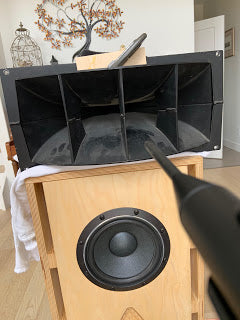This blog post features a full set of measurements on the Altec 806-8A compression driver mounted to the Altec 811B Horn. For interest's sake please see my other blog posts related to this...
Altec 806-8A on ES-600 Biradial
TAD TD-2001 on Altec 811B Horn
Measurement Test Setup
All measurements were done at 1 meter mic distnace using a 5ms gate to elminate my room's reflections above 1kHz. The horn had to be wrapped in a blanket and stretch wrapped to eliminate the bell ringing since the horn was not mounted into a bass enclosure.
Impedance Curve
|
Altec 806-8A with 811B Horn Impedance Curve |
Frequency Response
|
Altec 806-8A with 811B Horn Frequency Response |
Off-Axis Coloured Polar Map
This test was conducted with the TAD TD-2001 mounted to the Altec 811B since I had previously conducted this test already for a previous blog post.
|
Altec 811B with TAD TD-2001 Off-Axis Coloured Polar Map |
|
Altec 811B with TAD TD-2001 Off-Axis Waterfall Map |
Step Response
The step response takes 4.3 milliseconds to settle. This is the longest settle time for any high frequency horn that I've measured.
|
Altec 806-8A with 811B Horn Step Response |
Spectral Burst Decay
Burst decay shows broad spectrum resonances from 4kHz-10kHz.
|
Altec 806-8A with 811B Horn Spectral Burst Decay |
Subjective Listening Impression
I did not conduct this portion of the test. Please see my subjective impressions on this driver mounted to the ES-600 Biradial Horn by clicking here.
Conclusion
The 811B horn does nothing to help the performance of the 806-8A driver. In fact the 811B has rolloff starting at 8kHz which forces one to look at super tweeter options. The 811B does offer wide coverage from 1kHz to 8kHz however it is relatively ragged due to reflection artifacts which show up in the time domain measurements such as step response and burst decay. These artifacts will blur transient detail through the passband and at best give the horn a particular sonic signature of it's own.


